Spatial and Temporal Patterns of Carbon and Water Use Efficiency on the Loess Plateau and Their Influencing Factors
Abstract
:1. Introduction
2. Materials and Methods
2.1. Study Area
2.2. Data
2.3. Methods
3. Results
3.1. Spatial and Temporal Characteristics of Vegetation Carbon Use Efficiency and Water Use Efficiency
3.2. Spatial Distribution Characteristics of the Carbon and Water Use Efficiency of Vegetation on the Loess Plateau
3.3. Spatial Patterns of Precipitation and Temperature Variation on the Loess Plateau
3.4. Carbon and Water Use Efficiency of Vegetation in Response to Changes in Precipitation and Temperature
3.5. Impact of Human Activities on Vegetation Carbon and Water Use Efficiency
4. Discussion
5. Conclusions
Author Contributions
Funding
Conflicts of Interest
References
- Livingston, J.E.; Rummukainen, M. Taking science by surprise: The knowledge politics of the IPCC Special Report on 1.5 degrees. Environ. Sci. Policy 2020, 112, 10–16. [Google Scholar] [CrossRef]
- Medlyn, B.E.; De Kauwe, M.G.; Lin, Y.S.; Knauer, J.; Duursma, R.A.; Williams, C.A.; Arneth, A.; Clement, R.; Isaac, P.; Limousin, J.M.; et al. How do leaf and ecosystem measures of water-use efficiency compare? New Phytol. 2017, 216, 758–770. [Google Scholar] [CrossRef] [Green Version]
- Gang, C.; Yi, Z.; Liang, G.; Gao, X.; Wen, Z. Drought-Induced Carbon and Water Use Efficiency Responses in Dryland Vegetation of Northern China. Front. Plant Sci. 2019, 10, 224. [Google Scholar] [CrossRef] [PubMed] [Green Version]
- Houborg, R.; Anderson, M.C.; Daughtry, C.S.T.; Kustas, W.P.; Rodell, M. Using leaf chlorophyll to parameterize light-use-efficiency within a thermal-based carbon, water and energy exchange model. Remote Sens. Environ. 2011, 115, 1694–1705. [Google Scholar] [CrossRef]
- Zheng, H.; Lin, H.; Zhu, X.J.; Jin, Z.; Bao, H. Divergent spatial responses of plant and ecosystem water-use efficiency to climate and vegetation gradients in the Chinese Loess Plateau. Glob. Planet. Change 2019, 181, 102995. [Google Scholar] [CrossRef]
- Kwon, Y.; Larsen, C. Effects of forest type and environmental factors on forest carbon use efficiency (CUE) using MODIS and FIA data across the eastern USA. In Proceedings of the AGU Fall Meeting, San Francisco, CA, USA, 3–7 December 2012. [Google Scholar]
- Zheng, H.; Lin, H.; Zhou, W.; Bao, H.; Zhu, X.; Jin, Z.; Song, Y.; Wang, Y.; Liu, W.; Tang, Y. Revegetation has increased ecosystem water-use efficiency during 2000–2014 in the Chinese Loess Plateau: Evidence from satellite data. Ecol. Indic. 2019, 102, 507–518. [Google Scholar] [CrossRef]
- Sun, S.; Song, Z.; Wu, X.; Wang, T.; Wu, Y.; Du, W.; Che, T.; Huang, C.; Zhang, X.; Ping, B. Spatio-temporal variations in water use efficiency and its drivers in China over the last three decades. Ecol. Indic. 2018, 94, 292–304. [Google Scholar] [CrossRef]
- Ogutu, B.O.; D’Adamo, F.; Dash, J. Impact of vegetation greening on carbon and water cycle in the African Sahel-Sudano-Guinean region. Glob. Planet. Change 2021, 202, 103524. [Google Scholar] [CrossRef]
- Budny, M.L. The Impact of Willow Encroachment on Water and Carbon Exchange in the Vegetation of a Subtropical Wetland. Master’s Thesis, Florida Atlantic University, Boca Raton, FL, USA, 2015. [Google Scholar]
- Chen, Y.; Wei, T.; Ren, K.; Sha, G.; Guo, X.; Fu, Y.; Yu, H. The coupling interaction of soil organic carbon stock and water storage after vegetation restoration on the Loess Plateau, China. J. Environ. Manag. 2022, 306, 114481. [Google Scholar] [CrossRef]
- Wang, G.H. Can the restoration of natural vegetation be accelerated on the Chinese Loess Plateau? A study of the response of the leaf carbon isotope ratio of dominant species to changing soil carbon and nitrogen levels. Ecol. Res. 2006, 21, 188–196. [Google Scholar] [CrossRef]
- Gong, F.; Du, L.; Meng, C.; Dan, Y.; Wang, L.; Zheng, Q.; Ma, L. Characteristics of water use efficiency in terrestrial ecosystems and its influence factors in Ningxia Province. Acta Ecol. Sin. 2019, 39, 9068–9078. [Google Scholar]
- Liu, F.; Ye, X.; Guo, Q.; Li, X.; Liu, J. Spatio-temporal variation of carbon and water use efficiency of different land cover in the Poyang Lake Basin and their correlations with climate factors. Acta Ecol. Sin. 2021, 41, 694–706. [Google Scholar] [CrossRef]
- Qiu, Y.; Fu, B.; Wang, J.; Chen, L. Soil moisture variation in relation to topography and land use in a hillslope catchment of the Loess Plateau, China. J. Hydrol. 2001, 240, 243–263. [Google Scholar] [CrossRef]
- Li, J.; Ren, Z. Effects of land use change on values of NPP ecosystem services of Loess Plateau in northern Shaanxi. Chin. J. Ecol. 2005, 24, 1029–1032. [Google Scholar]
- Liu, Y.; Wang, Q.; Yang, Y.; Gang, C.; Li, J. Spatial-temporal dynamics of grassland NPP and its driving factors in the Loess Plateau, China. J. Appl. Ecol. 2019, 30, 2309–2319. [Google Scholar]
- Zhou, H.; Van Rompaey, A.; Wang, J.A. Detecting the impact of the ‘Grain for Green’ program on the mean annual vegetation cover in the Shaanxi province, China using SPOT-VGT NDVI data. Land Use Policy 2009, 26, 954–960. [Google Scholar] [CrossRef]
- Huete, A.; Didan, K.; Miura, T.; Rodriguez, E.P.; Gao, X.; Ferreira, L.G. Overview of the radiometric and biophysical performance of the MODIS vegetation indices. Remote Sens. Environ. Interdiscip. J. 2002, 83, 195–213. [Google Scholar] [CrossRef]
- Zhao, M.; Heinsch, F.A.; Nemani, R.R.; Running, S.W. Improvements of the MODIS terrestrial gross and net primary production global data set. Remote Sens. Environ. Interdiscip. J. 2005, 95, 164–176. [Google Scholar] [CrossRef]
- Lan, X.; Liu, Z.; Chen, X.; Lin, K.; Cheng, L. Trade-off between carbon sequestration and water loss for vegetation greening in China. Agric. Ecosyst. Environ. 2021, 319, 107522. [Google Scholar] [CrossRef]
- Xiong, Y.; Qiu, G. Using MODIS land products to estimate regional evapotranspiration. In Proceedings of the 2010 IEEE International Geoscience and Remote Sensing Symposium, Honolulu, HI, USA, 25–30 July 2010; pp. 3882–3885. [Google Scholar]
- Liu, Y.; Hiyama, T.; Yamaguchi, Y. Scaling of land surface temperature using satellite data: A case examination on ASTER and MODIS products over a heterogeneous terrain area. Remote Sens. Environ. Interdiscip. J. 2006, 105, 115–128. [Google Scholar] [CrossRef]
- Chen, Z.; Yu, G.; Wang, Q. Ecosystem carbon use efficiency in China: Variation and influence factors. Ecol. Indic. Integr. Monit. Assess. Manag. 2018, 90, 316–323. [Google Scholar] [CrossRef]
- Liu, Y.; Wang, Q.; Yang, Y.; Tong, L.; Li, J.; Zhang, Z.; Wang, Z. Spatiotemporal Dynamic of Vegetation Carbon Use Efficiency and Its Relationship with Climate Factors in China During the Period 2000–2013. Res. Soil Water Conserv. 2019, 26, 278–286. [Google Scholar]
- Zhang, Y.; Yu, G.; Yang, J.; Wimberly, M.C.; Zhang, X.; Tao, J.; Jiang, Y.; Zhu, J. Climate-driven global changes in carbon use efficiency. Glob. Ecol. Biogeogr. 2014, 23, 144–155. [Google Scholar] [CrossRef]
- Xia, L.; Wang, F.; Mu, X.; Jin, K.; Sun, W.; Gao, P.; Zhao, G. Water use efficiency of net primary production in global terrestrial ecosystems. J. Earth Syst. Sci. 2015, 124, 921–931. [Google Scholar] [CrossRef]
- Zhi, C. Spatiotemporal variation of productivity and carbon use efficiency of forests in Northeast China from 2000 to 2015. Chin. J. Appl. Ecol. 2019, 30, 206–213. [Google Scholar]
- Liu, X.; Hu, B.; Ren, Z. Spatiotemporal Variation of Water Use Efficiency and Its Driving Forces on the Loess Plateau during 2000–2014. Sci. Agric. Sin. 2018, 51, 302–314. [Google Scholar]
- Fu, G.; Zhou, Y.T.; Shen, Z.X.; Zhang, X.Z.; Shi, P.L.; He, Y.T.; Wu, J.S. Relationships between ecosystem respiration and environmental factors of alpine grazing meadows along an altitudinal gradient (4300–4700 m). Ecol. Environ. 2010, 19, 2789–2794. [Google Scholar]
- Niu, X.; Sun, P.; Liu, X.; Luan, J.; Liu, S. Net ecosystem carbon dioxide exchange in an oak (Quercus aliena) forest at transitional zone from subtropics to warm temperate, China. Acta Ecol. Sin. 2020, 40, 5980–5991. [Google Scholar]
- Kunchala, R.K.; Patra, P.K.; Kumar, K.N.; Chandra, N.; Attada, R.; Karumuri, R.K. Spatio-temporal variability of XCO2 over Indian region inferred from Orbiting Carbon Observatory (OCO-2) satellite and Chemistry Transport Model. Atmos. Res. 2022, 269, 106044. [Google Scholar] [CrossRef]
- Sawamoto, T.; Hatano, R.; Yajima, T.; Takahashi, K.; Isaev, A.P. Soil respiration in Siberian Taiga ecosystems with different histories of forest fire. Soil Sci. Plant Nutr. 2000, 46, 31–42. [Google Scholar] [CrossRef]
- Zhuang, Q.; He, J.; Lu, Y.; Ji, L.; Xiao, J.; Luo, T. Carbon dynamics of terrestrial ecosystems on the Tibetan Plateau during the 20th century: An analysis with a process-based biogeochemical model. Glob. Ecol. Biogeogr. 2010, 19, 649–662. [Google Scholar] [CrossRef]
- Chen, H.; Ren, Z.Y. Response of Vegetation Coverage to Changes of Precipitation and Temperature in Chinese Mainland. Bull. Soil Water Conserv. 2013, 2, 18. [Google Scholar]
- Chuai, X.; Guo, X.; Zhang, M.; Yuan, Y.; Li, J. Vegetation and climate zones based carbon use efficiency variation and the main determinants analysis in China. Ecol. Indic. 2020, 111, 105967. [Google Scholar] [CrossRef]
- Gebregergis, Z. Effect of Elevated Carbon Dioxide, CO2 and Temperature on Crop Production: A Review. J. Natl. Sci. Res. 2016, 6, 42–46. [Google Scholar]
- Mu, S.J.; Zhou, K.X.; Qi, Y.; Chen, Y.Z.; Fang, Y.; Zhu, C. Spatio-temporal patterns of precipitation-use efficiency of vegetation and their controlling factors in Inner Mongolia. Chin. J. Plant Ecol. 2014, 38, 1–16. [Google Scholar]
- Bachman, S.; Heisler-White, J.L.; Pendall, E.; Williams, D.G.; Newcomb, M.J. Elevated carbon dioxide alters impacts of precipitation pulses on ecosystem photosynthesis and respiration in a semi-arid grassland. Oecologia 2010, 162, 791–802. [Google Scholar] [CrossRef]
- Gosselin, N. Assessing Climate Change Effects on Soil and Vegetation Carbon Dynamics Using a Temperature and Precipitation Bias Correction Technique. In Proceedings of the 28th Conference on Hydrology, Atlanta, GA, USA, 4 February 2014. [Google Scholar]
- Groenendijk, M.; Dolman, A.J.; Molen, M.; Leuning, R.; Arneth, A.; Delpierre, N.; Gash, J.; Lindroth, A.; Richardson, A.D.; Verbeeck, H. Assessing parameter variability in a photosynthesis model within and between plant functional types using global Fluxnet eddy covariance data. Agric. For. Meteorol. 2011, 151, 22–38. [Google Scholar] [CrossRef]
- Heskel, M.A.; Bitterman, D.; Atkin, O.; Turnbull, M.; Griffin, K.L. Seasonal dynamics of photosynthesis and respiration in Arctic tundra species under warming. In Proceedings of the 97th ESA Annual Convention 2012, Portland, OR, USA, 5–10 August 2012. [Google Scholar]
- Luus, K.A.; Lin, J.C. The Polar Vegetation Photosynthesis and Respiration Model (PolarVPRM): A parsimonious, satellite data-driven model of high-latitude CO2 exchange. Geosci. Model Dev. Discuss. 2015, 8, 979–1027. [Google Scholar]
- Henderson, B.A.; Trivedi, T.; Collins, N. Annual cycle of energy allocation to growth and reproduction of yellow perch. J. Fish Biol. 2010, 57, 122–133. [Google Scholar] [CrossRef]
- Kesarcodi-Watson, A.; Klumpp, D.W.; Lucas, J.S. Comparative feeding and physiological energetics in diploid and triploid Sydney rock oysters (Saccostrea commercialis): II. Influences of food concentration and tissue energy distribution. Aquaculture 2001, 203, 195–216. [Google Scholar] [CrossRef]
- Way, C.M. Seasonal allocation of energy to respiration, growth and reproduction in the freshwater clams, Pisidium variabile and P. compressum (Bivalvia: Pisidiidae). Freshw. Biol. 2010, 19, 321–332. [Google Scholar] [CrossRef]
- Astover, A.; Roostalu, H.; Motte, M.; Tamm, I.; Vasiliev, N.; Lemetti, I. Decision support system for agricultural land use and fertilisation optimisation: A case study on barley production in Estonia. MTT Agrifood Res. Finl. 2006, 15, 77–88. [Google Scholar] [CrossRef]
- Sušin, J.; Kmecl, V.; ŽnidaršičPongrac, V.; Briški, L. Fertilisation of agricultural land in the ground water sources areas in the Ljubljana community. Diabetologia 2000, 51, 328–335. [Google Scholar]
- Carbonell-Bojollo, R.M.; Veroz-González, Ó.; González-Sánchez, E.J.; Ordóñez-Fernández, R.; Moreno-García, M.; De Torres, M.A.R.-R. Soil Management, Irrigation and Fertilisation Strategies for N2O Emissions Mitigation in Mediterranean Agricultural Systems. Agronomy 2022, 12, 1349. [Google Scholar] [CrossRef]
- Xiao, H.J.; Ding, G.D.; Jia, R.Y.; Ma, S.-L. Changes of vegetation and soil environment of wasteland in the early period of eco-restoration in Beijing suburb—A case study of Yanqing. Agric. Res. Arid Areas 2005, 23, 202–206. [Google Scholar]
- Zou, J.; Ding, J.; Yang, S. Spatial and temporal variation analysis of ecosystem water use efficiency in Central Asia and Xinjiang in recent 15 years. Geogr. Res. 2017, 36, 1742–1745. [Google Scholar]
- Suzuki, J.; Nakayama, K. Soil Moisture Condition and Evapotranspiration in a Maize Field under the Summer Condition of High Temperature and Low Rainfall. J. Agric. Meteorol. 2010, 52, 233–240. [Google Scholar] [CrossRef]
- Griffin, A. Using LiDAR and normalized difference vegetation index to remotely determine LAI and percent canopy cover at varying scales. In Proceedings of the SilviLaser 2008, 8th International Conference on LiDAR Applications in Forest Assessment and Inventory, Edinburgh, UK, 17–19 September 2008. [Google Scholar]
- Hsiao, T.C. Interactive Effects of Elevated CO{sub 2}, Drought and High Temperature on Plant Water Use Efficiency; Office of Scientific & Technical Information Technical Reports; USDOE Oakland Operations Office: Oakland, CA, USA, 1998.
- Beeson, R.C. Response of Evapotranspiration of Viburnum odoratissimum to Canopy Closure and the Implications for Water Conservation during Production and in Landscapes. Hortsci. A Publ. Am. Soc. Hortic. Sci. 2010, 45, 359–364. [Google Scholar] [CrossRef] [Green Version]
- Wu, Y.; Wang, W.; Li, W.; Zhao, S.; Wang, S.; Liu, T. Assessment of the spatiotemporal characteristics of vegetation water use efficiency in response to drought in Inner Mongolia, China. Environ. Sci. Pollut. Res. 2022. [Google Scholar] [CrossRef]
- Dai, J. Response of Robinia Pseudoacacia First Leaf Date to temperature and Precipitation Change in China in the Past 50 Years. In Proceedings of the International Congress of Biometeorology, Cleveland, OH, USA, 30 September 2014. [Google Scholar]
- Pei, T.; Li, X.; Wu, H.; Wu, X.; Chen, Y.; Xie, B. Sensitivity of vegetation water use efficiency to climate and vegetation index in Loess Plateau, China. Trans. Chin. Soc. Agric. Eng. 2019, 35, 119–125. [Google Scholar]
- Zhan, Z.Y.; Yu, Y.M.; Chen, T.T.; Xu, L.J.; Ou, C.Q. Effects of hourly precipitation and temperature on ambulance response time. Environ. Res. 2019, 181, 108946. [Google Scholar] [CrossRef] [PubMed]
- Liu, Z.; Ye, J.P.; Ouyang, L.; Sheng, F.; Liu, S.Y. Hydrological effects of vegetation restoration and the threshold for its response to annual precipitation in Pengchongjian small watershed, Jiangxi, China. J. Appl. Ecol. 2018, 29, 3705–3711. [Google Scholar]
- Santiago, L.S.; Silvera, K.; Andrade, J.L.; Dawson, T.E. Functional strategies of tropical dry forest plants in relation to growth form and isotopic composition. Environ. Res. Lett. 2017, 12, 115006. [Google Scholar] [CrossRef] [Green Version]
- Xu, M.; Li, W.; Wang, J.; Zhu, Y.; Feng, Y.; Yang, G.; Zhang, W.; Han, X. Soil ecoenzymatic stoichiometry reveals microbial phosphorus limitation after vegetation restoration on the Loess Plateau, China. Sci. Total Environ. 2022, 815, 152918. [Google Scholar] [CrossRef] [PubMed]
- Zhang, L.; Lv, J. Linkages between soil respiration and soil eukaryotic microalgae following vegetation restoration in the Loess Plateau, China. Land Degrad. Dev. 2022, 33, 881–891. [Google Scholar] [CrossRef]


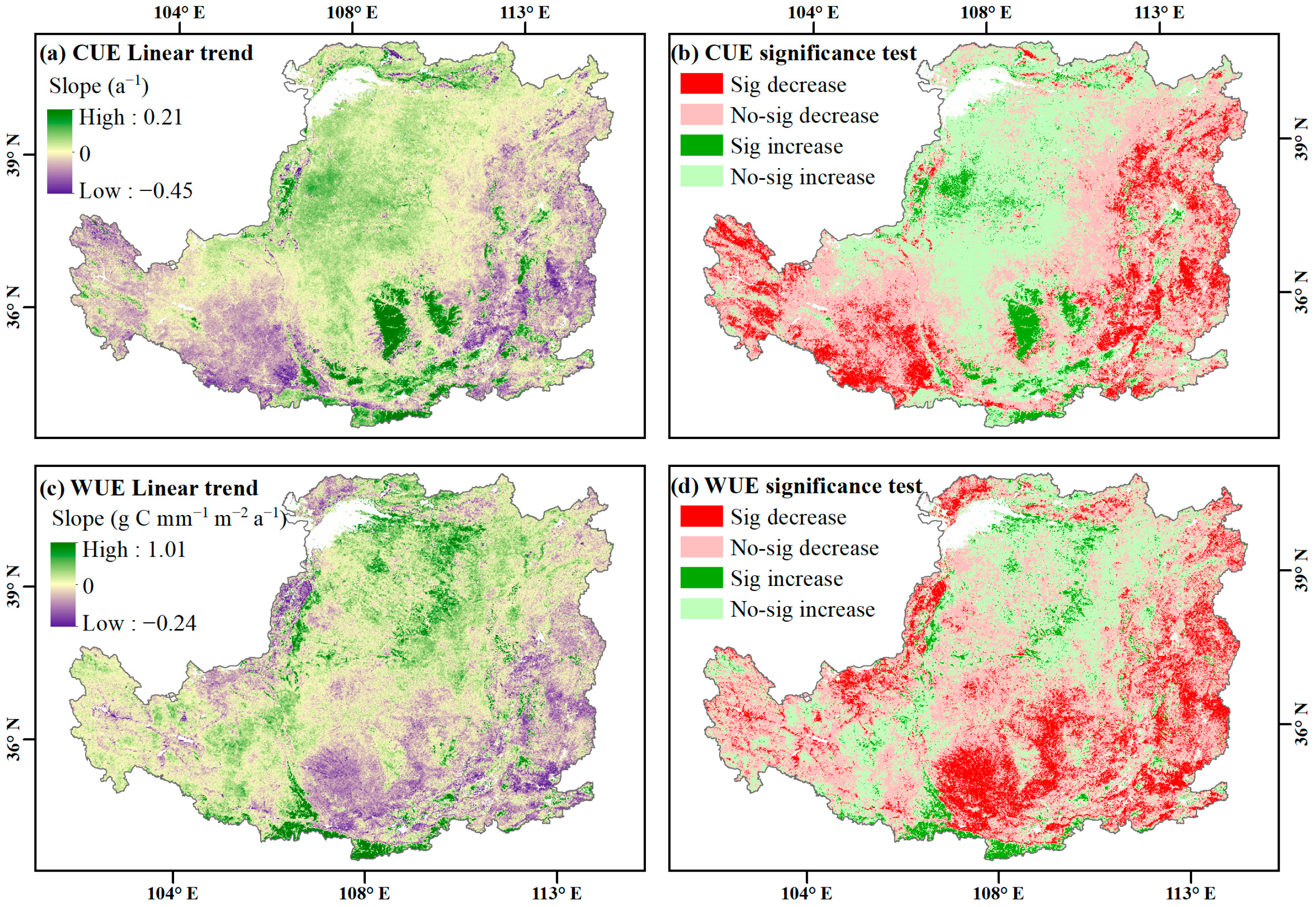
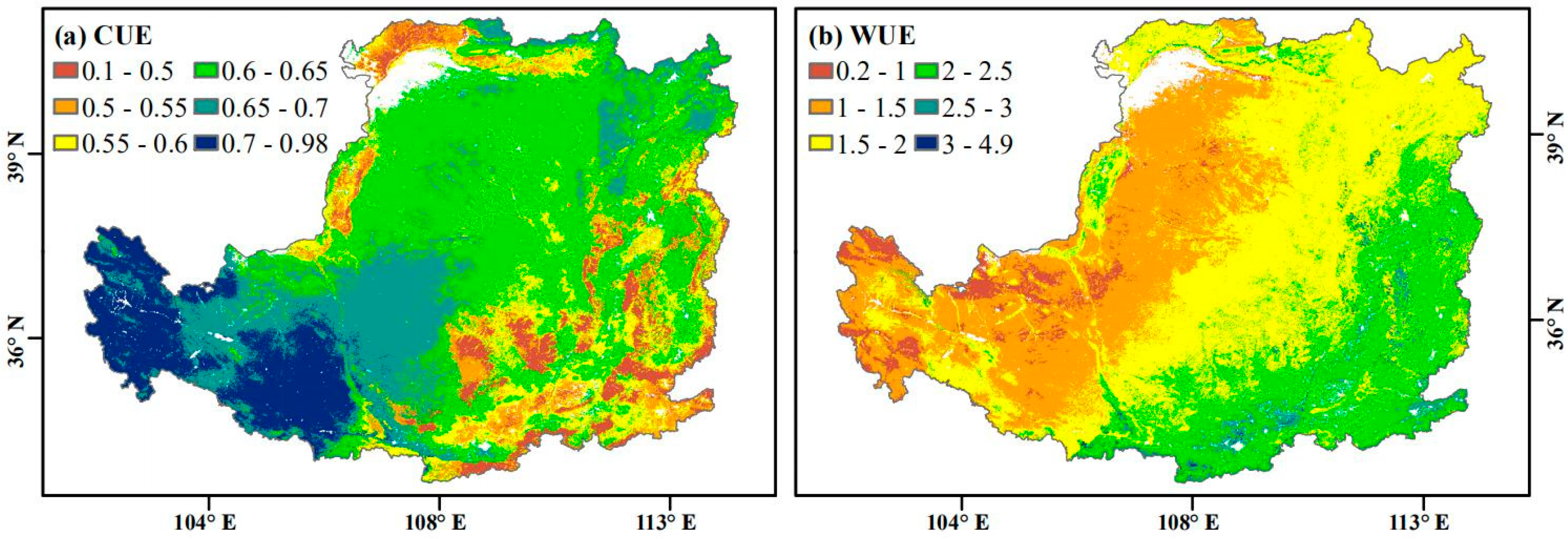

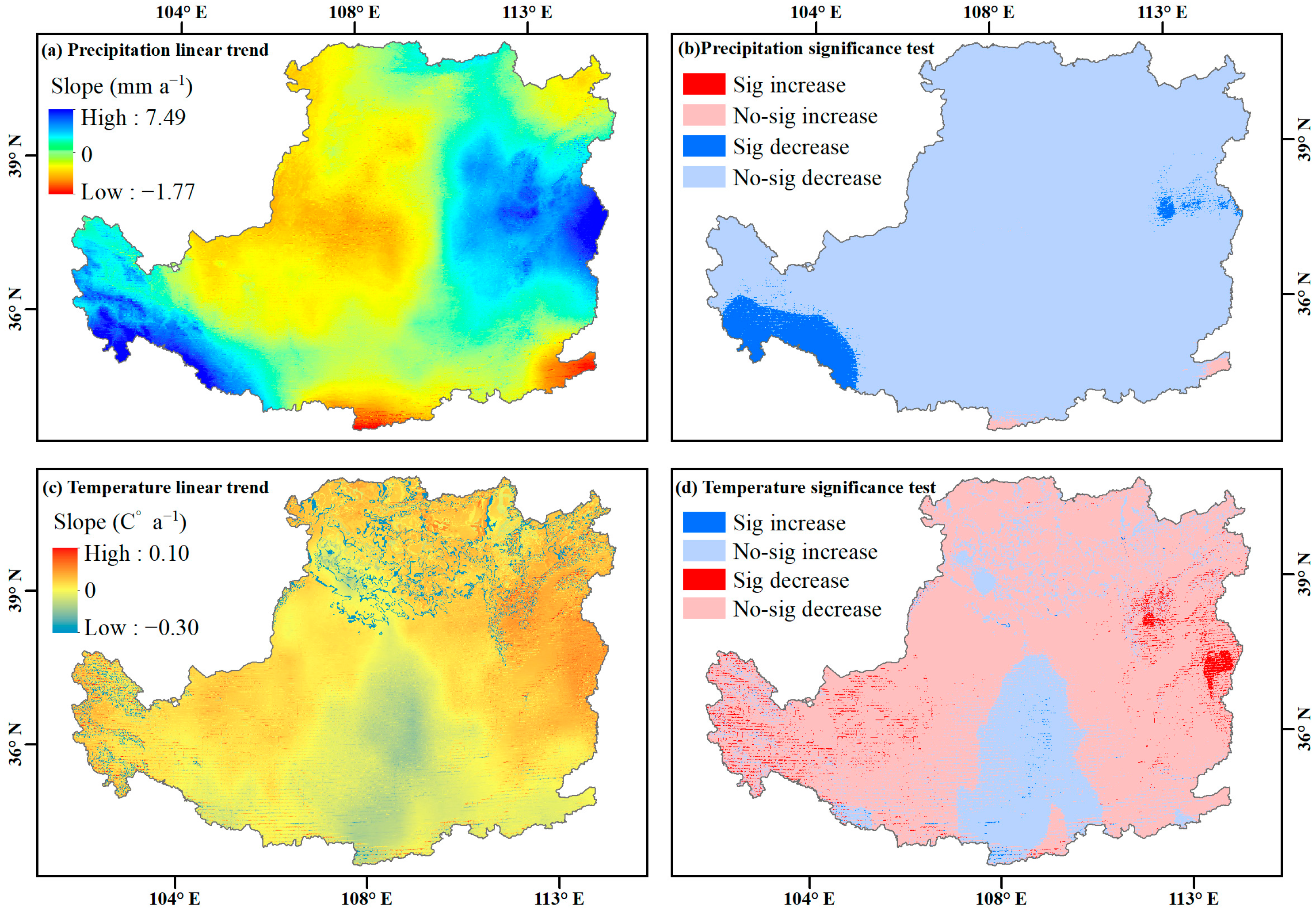
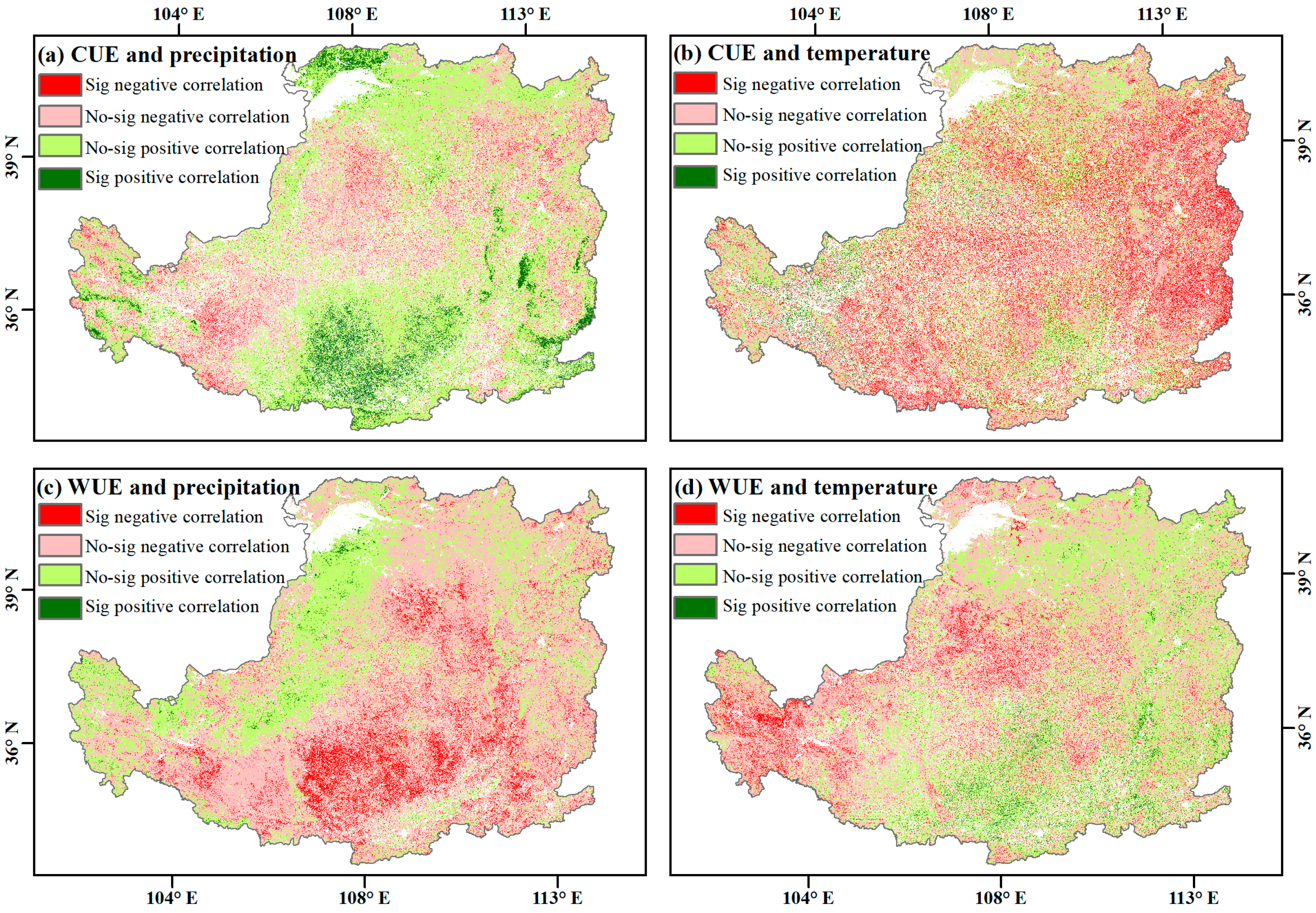
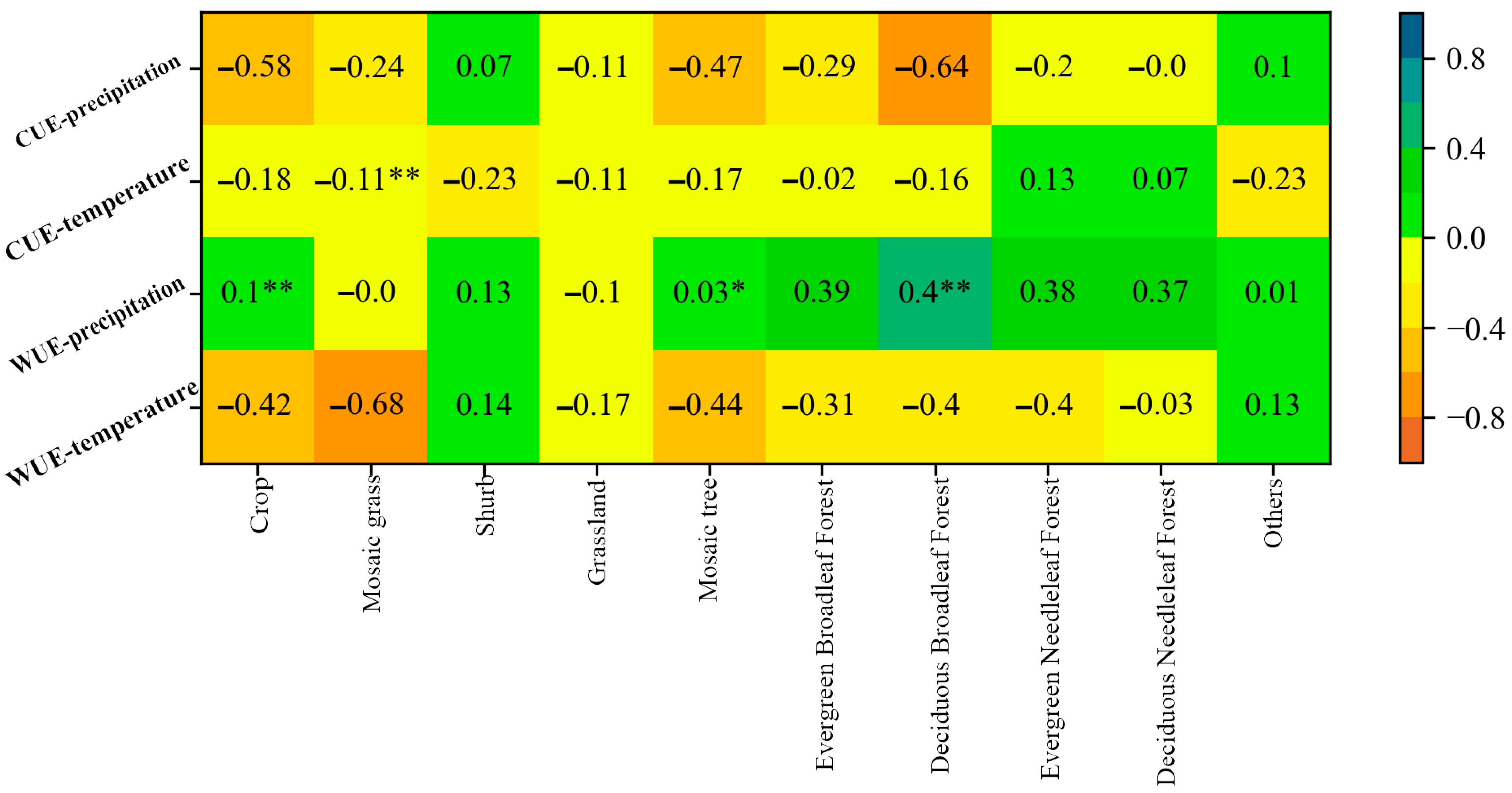

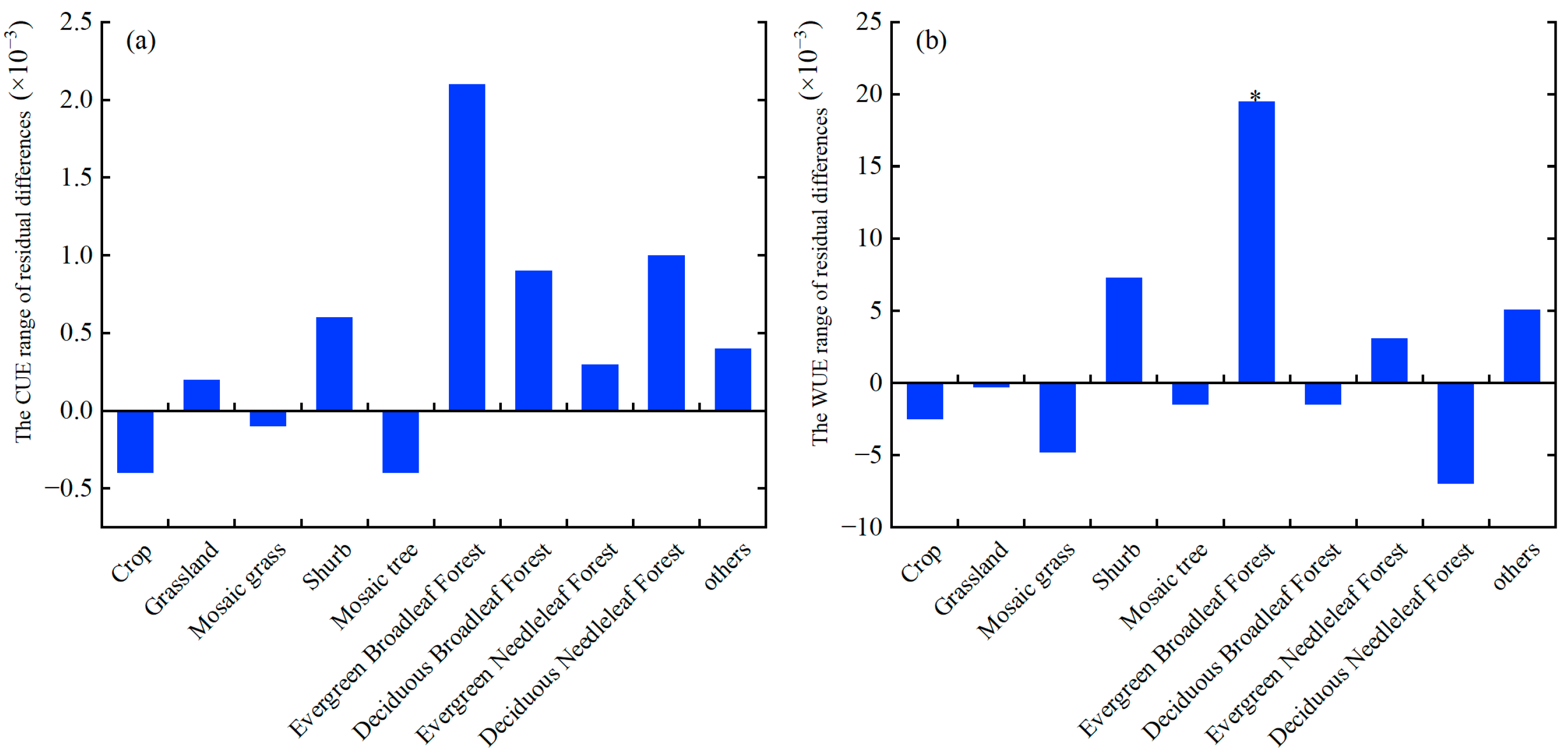
| Data | Acronym | Data ID | Resolution | Data Format |
|---|---|---|---|---|
| Gross Primary Production | GPP | MOD17A2Hv006 | 500 m·8 d−1 | HDF |
| Net Primary Production | NPP | MOD17A3HGFv-006 | 500 m·a−1 | HDF |
| Evapotranspiration | ET | MOD16A2v006 | 500 m·8 d−1 | HDF |
Disclaimer/Publisher’s Note: The statements, opinions and data contained in all publications are solely those of the individual author(s) and contributor(s) and not of MDPI and/or the editor(s). MDPI and/or the editor(s) disclaim responsibility for any injury to people or property resulting from any ideas, methods, instructions or products referred to in the content. |
© 2022 by the authors. Licensee MDPI, Basel, Switzerland. This article is an open access article distributed under the terms and conditions of the Creative Commons Attribution (CC BY) license (https://creativecommons.org/licenses/by/4.0/).
Share and Cite
Zhang, Q.; Lu, J.; Xu, X.; Ren, X.; Wang, J.; Chai, X.; Wang, W. Spatial and Temporal Patterns of Carbon and Water Use Efficiency on the Loess Plateau and Their Influencing Factors. Land 2023, 12, 77. https://doi.org/10.3390/land12010077
Zhang Q, Lu J, Xu X, Ren X, Wang J, Chai X, Wang W. Spatial and Temporal Patterns of Carbon and Water Use Efficiency on the Loess Plateau and Their Influencing Factors. Land. 2023; 12(1):77. https://doi.org/10.3390/land12010077
Chicago/Turabian StyleZhang, Qi, Jinxin Lu, Xuexuan Xu, Xiuzi Ren, Junfeng Wang, Xiaohong Chai, and Weiwei Wang. 2023. "Spatial and Temporal Patterns of Carbon and Water Use Efficiency on the Loess Plateau and Their Influencing Factors" Land 12, no. 1: 77. https://doi.org/10.3390/land12010077





